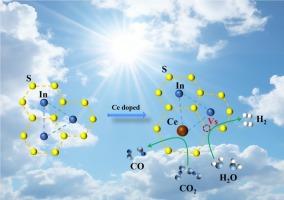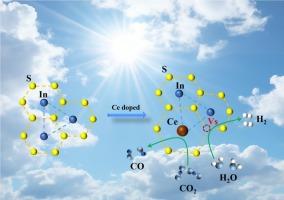Surface Ce single atoms and S-vacancies synergically enhanced photoreduction of CO2 over Ce-ZnIn2S4 nanosheets
IF 4.3
2区 工程技术
Q2 ENGINEERING, CHEMICAL
引用次数: 0
Abstract
The rare intrinsic active sites and low charge transfer capabilities of catalysts cause the unsatisfied selectivity and activity in photocatalytic reduction of CO2. Utilizing single atoms doping into a catalyst to overcome these issues for improving the catalytic performance may be a highly desirable and challenging endeavor. Herein, single atoms Ce doped ZnIn2S4 (ZIS) nanosheets were prepared as photocatalysts for the reduction of CO2 under visible light, achieving efficient syngas production of 19.8 mmol g−1h−1, with an adjustable CO/H2 ratios from 1:4 to 1:1. Characterizations results reveal that Ce single atoms sites are dispersed on the surface of ZIS, forming the abundant S-vacancies via the lattice distortion of ZIS. These Ce single atoms sites and S-vacancies (Sv) can greatly enhance the separation and transport efficiency of photogenerated carriers. Density functional theory calculations and experiment results exhibit that electrons-rich Ce atoms can selectively absorb and reduce CO2, while Sv serve as the active sites for the reduction of H2O. This work offers a unique horizon for constructing single-atom doped catalysts and understanding the synergistic catalytic pathway of surface metal single atoms and vacancies.


表面Ce单原子和s -空位协同增强了Ce- znin2s4纳米片上CO2的光还原
由于催化剂的本征活性位点稀少和电荷转移能力低,导致光催化还原CO2的选择性和活性不理想。利用单原子掺杂到催化剂中来克服这些问题以提高催化性能可能是一个非常理想和具有挑战性的努力。本文制备了单原子Ce掺杂ZnIn2S4 (ZIS)纳米片,作为可见光下CO2还原的光催化剂,在CO/H2比例为1:4 ~ 1:1的情况下,合成气产量可达19.8 mmol g−1h−1。表征结果表明,Ce单原子位分散在ZIS表面,通过ZIS的晶格畸变形成了丰富的s空位。这些Ce单原子位和s空位(Sv)可以大大提高光生载流子的分离和传输效率。密度泛函理论计算和实验结果表明,富电子的Ce原子可以选择性地吸收和还原CO2,而Sv是还原H2O的活性位点。这项工作为构建单原子掺杂催化剂和理解表面金属单原子与空位的协同催化途径提供了一个独特的视角
本文章由计算机程序翻译,如有差异,请以英文原文为准。
求助全文
约1分钟内获得全文
求助全文
来源期刊

Chemical Engineering Science
工程技术-工程:化工
CiteScore
7.50
自引率
8.50%
发文量
1025
审稿时长
50 days
期刊介绍:
Chemical engineering enables the transformation of natural resources and energy into useful products for society. It draws on and applies natural sciences, mathematics and economics, and has developed fundamental engineering science that underpins the discipline.
Chemical Engineering Science (CES) has been publishing papers on the fundamentals of chemical engineering since 1951. CES is the platform where the most significant advances in the discipline have ever since been published. Chemical Engineering Science has accompanied and sustained chemical engineering through its development into the vibrant and broad scientific discipline it is today.
 求助内容:
求助内容: 应助结果提醒方式:
应助结果提醒方式:


